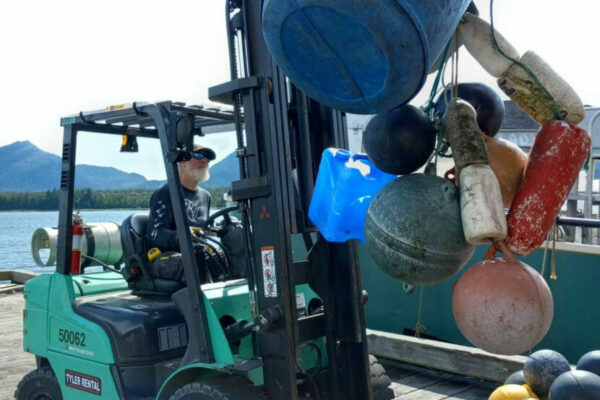
Crews in Ketchikan hauled enormous cloth bags full of garbage off of the F/V Polar Lady last week — 11,500 pounds in all. It all came from the remote Forrester Island, an uninhabited islet 40 or so miles southwest of Prince of Wales Island, known as Gaskuu in the Haida language.
The debris is bound for recycling in Seattle, but researchers hope it could also shed light on the kinds of garbage that find their way into the ocean.
Kit Cunningham is studying the garbage as part of a research project for her thesis. She’s a technician with the state department of Fish and Game’s marine mammal program and a graduate student at the University of Alaska Fairbanks.
“I want to know where the debris is coming from and how long it’s been in the water,” she said. “And one way we’re kind of looking into that is if there’s any growth on the marine debris.”
That growth is known as biofouling. Things like algae, barnacles and the like can offer clues about the origin of the marine debris that washes ashore.
“There’s always been quite a bit of trash and marine debris out there, so it was kind of the perfect candidate,” she said.
Working in shifts, Cunningham and two crews spent just over a month picking up trash on the island. The work was funded by a National Oceanic and Atmospheric Administration grant program.
But why does so much debris pile up on this particular island in the North Pacific?
Cunningham said the location may have something to do with it.
“It’s something that I’m still learning about right now, but I would guess that since it’s along the continental shelf, a lot of currents go through there — there’s actually some really cool photos of storms rolling in,” she said. “And Forrester, Gaskuu, it’s actually the first thing they hit. So, I think just a lot of currents and storms, it’s just a perfect catching spot.”
Alaska General Seafoods provided two tenders and a skiff for the removal work. Alaska Marine Lines provided two, 40-foot-long shipping containers to transfer the garbage to Seattle.
Among the debris were a few glass buoys and bottles — one even had a note inside.
“It was pretty wild,” she said. “It was actually someone writing to a loved one who had passed, and just expressing a lot of love and appreciation for that person.”
But perhaps more interesting to Cunningham are the plastics: mostly old buoys, bottles and plastic foam.
She said her research into the debris could last into next summer, and she’ll try to determine what kinds of plastics were most common on the island.
But she’s not just studying the trash. While she was on the island, Cunningham collected the vomit samples from sea birds and fecal samples from Steller sea lions. She’ll be sending those to a professor to see if there are any microplastics in the animal’s diets.
If there are, she wants to learn if it’s the same kind of plastic found on the island. She’s expecting results later this year.
[Sign up for Alaska Public Media’s daily newsletter to get our top stories delivered to your inbox.]




